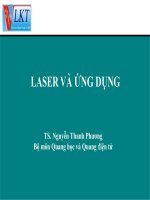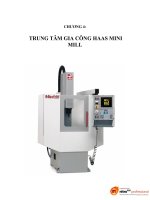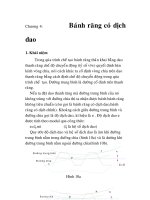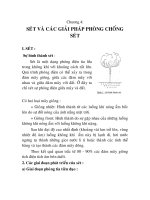LASER VÀ ỨNG DỤNG (TS. Nguyễn Thanh Phương) - CHƯƠNG 4 potx
Bạn đang xem bản rút gọn của tài liệu. Xem và tải ngay bản đầy đủ của tài liệu tại đây (4.97 MB, 67 trang )
LASER VÀ
ỨNG DỤNG
TS. Nguyễn Thanh Phương
Bộ
môn Quang học và
Quang điện tử
Chương IV:
Các loại laser và
ứng dụng
17/04/2011 3
Chương IV: Các loại laser và
ứng dụng
Nhắc lại: những yếu tố cấu thành laser
•
tương tác giữa ánh sáng và vật chất
•
đảo mật độ tích lũy
•
môi trường khuếch đại thích hợp
•
buồng cộng hưởng quang học
•
tương tác giữa một buồng cộng hưởng quang học và
khuếch đại bên trog BCH:
-ngưỡng phát laser
-
so sánh mode và
lọc lựa mode
-
bão hòa khuếch đại
-phương trình tốc độ
của laser
-
we now want to get an overview about the different types of lasers, which
are practically relevant.
IV.1. Laser rắn
Chương IV:
Các loại laser và
ứng dụng
17/04/2011 9
…Ruby (Rubin) continued
optical and laser properties
of ruby at room temperature
IV.1. Laser rắn
17/04/2011 10
Neodymium Lasers
6.3.2. Neodymium LasersIV.1. Laser rắn
17/04/2011 11
•
crystal
-
Nd:YAG
is the most important material used for solid state laser systems.
YAG
stands for
Yttrium-Aluminum-Garnet, Y
3
Al
2
O
12
, a colourless, isotropic
crystal. For a Nd:YAG laser rod ~1% of the Y
3+
ions is replaces by Nd
3+
ions. The YAG-structure is very stable
from lowest to highest temperature,
its mechanical stability
and
workability
(growing, grinding, polishing) as well
as the achievable optical quality are good.
•
first realized with glass1961, with YAG 1964.
absorption spectrum
of Nd:YAG
IV.1. Laser rắn
17/04/2011 12
… Nd:Lasers continued
-
level scheme of Nd:YAG
-
"strongest" laser transition at
1064.1 nm
-
lasing is mainly supported by the R
2
sub-level of the
4
F
3/2
level. At room
temperature ~40% of
4
F
3/2
atoms
are in R
2
(Ê Boltzmann).
-
lower laser level is
4
I
11/2
with various
sub-levels, which all give slightly
different emission wavelength.
-
lower laser levels are thermally not
populated, so inversion can easily
be achieved, even for cw-operation.
-
Nd:YAG is a four-level laser, it is
homogeneously broadened
τ
~240µs
fast, non-
radiative
decay
fast, non-
radiative
decay
IV.1. Laser rắn
17/04/2011 13
•
applications
-
material processing (cw
and pulsed lasers)
welding (Schweißen), marking, writing, drilling (Bohren) (sizes of few µm
possible), cutting
-
illumination and ranging (military)
-
medical, especially ophthalmology (Augenheilkunde)
-
pumping of other lasers
(e.g. frequency doubled Nd:YAG for pumping of
Ti:Sa lasers) and non-linear optics
(e.g. frequency doubling [532 nm],
tripling [355 nm], quadrupling [256 nm], parametric conversion).
-
Nd:glass lasers and corresponding amplifiers are also used for laser fusion
experiments
IV.1. Laser rắn
17/04/2011 14
•
discharge pumping
-
cw-lasers are pumped by diode lasers
at ~ 810nm or various types of
discharge lamps or filament lamps, pulsed lasers by flash lamps.
-
energy corresponding to non-radiative
decays limits quantum efficiency
to
~ 76%. Excess power (~24%) is converted into
heat, which has to be
dissipated. Light not absorbed by the pump bands is also partially
converted into heat
-
examples
for
pumping
cw-Nd:YAG lasers
IV.1. Laser rắn
17/04/2011 15
-
discharge lamps (cw)
… discharge pumping continued
-
discharge/filament tube
is mounted inside a flow
tube
which carries the
coolant (liquid).
-
typical electrical power: ~ 1…10 kW,
~ (100V, 50 A)
-
lifetimes few 10h … ~ 1000 h
-
arc length ~ 50mm
arc lamps
filament lamps
-
typical electrical power: ~ 1kW,
-
lifetimes ~100h
-
filament length ~ 50mm
IV.1. Laser rắn
17/04/2011 17
-
depending on requested power different "pump cavity" designs are
used for
discharge pumped lasers.
… discharge pumping continued
Elliptical cross sections
are the basis for many of these geometries, where
the discharge tube is located at one focus
and the laser rod at the other.
IV.1. Laser rắn
17/04/2011 18
… discharge pumping continued
-
thermal loading
pulsed Nd:YAG lasers as well as other solid-state systems can provide
very high peak powers
(many GW) and large pulse energies (many joules).
Especially if lamps (~ 10 kW electric power each) are used for pumping,
thermal loading
of the crystal
is a serious, power-limiting
issue.
Absorption of pump plight outside the pump band, and heating due to non-
unity quantum efficiency
•
will induce thermal lensing
through temperature dependence of the
index of refraction. This modifies the resonator geometry dynamically!
•
thermal stress
causes
birefringence
and can even lead to damage of
the crystal.
Reduction of problems arising from thermal loading requires
•
uniform pumping
•
good heat removal
IV.1. Laser rắn
17/04/2011 20
-
slab geometry
a slab geometry provides a number of advantages over rod-designs:
•
pumping is more homogeneous
•
larger surface per volume (better heat removal)
•
temperature gradients only in y-direction.
⇒
cartesian
symmetry helps to avoid thermal stress induced
depolarization
problems (laser emissions is already
polarized in the y-z plane due to Brewster cut of crystal)
… discharge pumping continued
IV.1. Laser rắn
17/04/2011 21
-
different slab geometries exist
… discharge pumping continued
multiple flash
lamp
design
single
(dual) flash
lamp
design
IV.1. Laser rắn
17/04/2011 22
-
disk geometry
beneficial for ultra-high power pulsed solid-state laser systems like those
used for laser fusion (at Lawrence Livermore National Laboratory):
… discharge pumping continued
-
better cooling,
-
larger aperture (∅
>70cm )
-
better gain uniformity
-
better beam quality
IV.1. Laser rắn
17/04/2011 23
•
diode pumping
-
high pumping efficiency, because diode lasers at 810nm match Nd:YAG
absorption bands very well
⇒ reduction of thermal load problems (thermal lensing, thermal
birefringence)
⇒ improved total electrical-to-optical efficiency
-
better pump beam quality: pump laser light can be focused into the gain
volume (especially for end-pumped systems)
-
longer MTBF
(mean time between failure): typically 10.000 h for diode
lasers vs. a few hundred h to about 1000 h for discharge lamps.
-
operation simplified: reduced cooling requirements, no high voltage
"spikes", no UV-light which degrades crystal, optics and coolant.
-
a single diode laser
can provide a few W cw-power
(typically not
fundamental mode). Single transverse mode laser diodes with ~0.1
W up to
1 W output power exist. Sometimes broad stripe diode lasers, 1D-arrays
("bars") or 2D-arrays
can be used.
IV.1. Laser rắn
17/04/2011 26
… diode pumping continued
-
there are several geometries for optical pumping with laser diodes
•
end pumped systems
(single and double)
-
pump light can be matched to mode volume
IV.1. Laser rắn
17/04/2011 27
… diode pumping continued
•
side pumping of a rod
-
direct coupling (diodes
close to amplifier)
-
coupling with optics
-
fiber
coupling (!)
•
achievable: optical cw-pumping
at ~10kW, cw-output typical
100W, up to ~1kW
IV.1. Laser rắn
17/04/2011 29
… Nd:Lasers continued
A MISER
oscillator (Monolithic
Isolated Single-mode End-pumped
Ring), or alternatively, an NPRO
(Non-Planar Ring-Oscillator):
the crystal itself constitutes the
amplifier, optical resonator, and
optical diode
to enforce uni-
directional oscillation.
T. J. Kane
and R. L. Byer, Opt. Lett. 10 (2), 65 (1985) ;
I. Freitag et al., Opt. Commun. 115, 511 (1995)
-
physical, optical, thermal properties
of Nd:YAG
IV.1. Laser rắn
17/04/2011 30
•
other solid state lasers
IV.1. Laser rắn
17/04/2011 31
Tuning range for various transition metal solid state lasers
large tuning range
of Ti:Sa is basis
for ultra-short
pulse operation
… other solid state lasers continued
IV.1. Laser rắn
17/04/2011 32
cw-Ti:Sa laser
system Coherent MBR 110, tuning range
-
further information regarding Ti:Sa lasers see 2.3.4
IV.1. Laser rắn
IV.1. Laser rắn
Chương IV:
Các loại laser và
ứng dụng
IV.2. Laser khí
17/04/2011 37
•
pumping
there are different methods of pumping.
-
chemical lasers: inversion is generated through a chemical reaction
-
gas-dynamical lasers: through fast adiabatic expansion, the gas is
transferred to a non-equilibrium state. It approaches a new equilibrium at
lower temperature, but for some gases and transitions the lower laying
rotational vibrational
states re-thermalize
faster than some excited
rotational vibrational
state: transient inversion
between rotational-
vibrational
states is generated.
-
optical pumping
(with another laser)
-
most common type is based on a continuous or pulsed discharge
•
general features
-
gas lasers are among the most powerful
(cw
and pulsed) lasers.
However, the beam profile, linewidth, stability, and tuneability
can
typically not compete
with dye lasers, solid state lasers, or diode lasers.
IV.2. Laser khí









